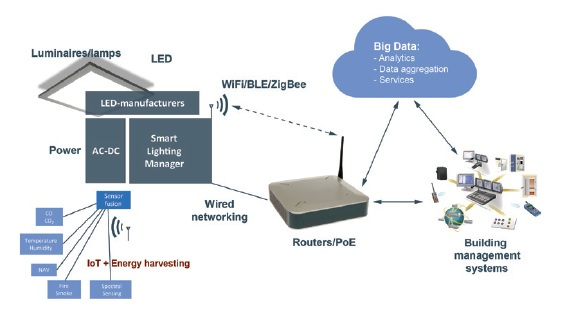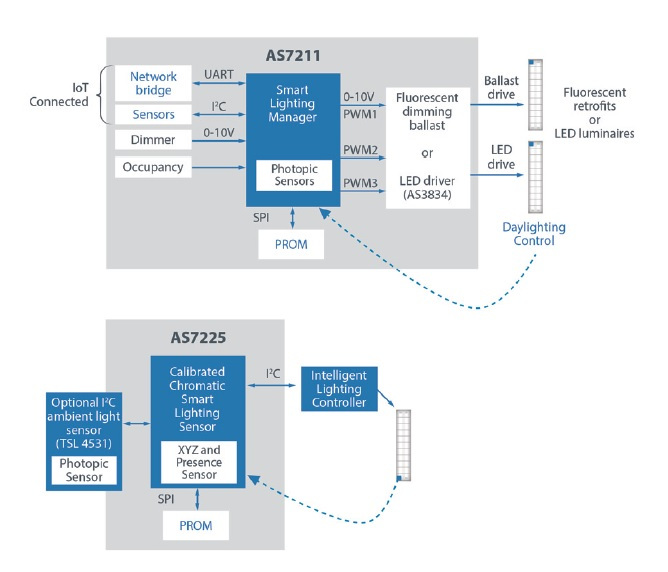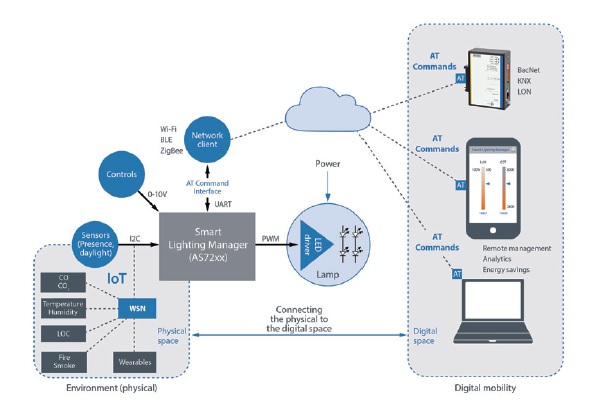Everything becomes "clever". Especially with things related to the Internet of Things (IoT), its enormous market growth potential has long been predicted. The new possibilities of the network and the huge data resulting from it provide countless product visions. For example, at breakfast, the kitchen equipment prepares fresh coffee and hot bread; during washing, the washing machine automatically stops the laundry before the red socks dye all white clothes pink; in addition there is a lighting system that can automatically adapt to the environment— Whether it is at home, shopping mall or street.
With the introduction of light-emitting diodes (LEDs), the thinking and design process has undergone enormous changes. In order to use a more effective control system, we must learn new knowledge of electronics and need to produce new designs and new functions. The use of light in a smart way is almost endless.
For example, luminaires are ideal sensor nodes. Each room has a light, and some lamps are usually located in a central location. Adding more intelligence through sensors is an easy task, such as light quality, temperature, humidity, air quality, or presence. These data can be collected and transmitted to other network devices in the center via the center, and the system can only react accordingly when the correct data is collected. The correct combination is very important: how to build a bridge between the physical world and the digital world? What are the requirements for putting the sensor in the luminaire?
Data collection and "smart" use: creating awareness <br> Viewing the basic elements of most buildings, including walls, doors, windows, furniture or gathering areas, air conditioning or ventilation systems, and lighting equipment, given the distribution of electrical networks and each The fact that the rooms have lighting fixtures is indeed a "hot spot". why? Because the luminaires have everything they need: electricity, the central location of the room, and people. What exactly do you want to detect? This is a manufacturer's consideration. They have to use unique knowledge to formulate sales strategies that cannot be copied quickly. Air quality and humidity are ideal parameters that can be added to building automation. This saves energy and increases the efficiency of the system. However, active lighting control can also ensure that employees are full of energy and flexibility throughout the working day, so that employees always maintain their morale. For many specifications of Energy Star and other international standards, smart sensors and control concepts have become increasingly important. Of course, the use of sensor technology will increase the bill of materials (BOM) costs. However, what we should ask here is: “What kind of added value can this create?â€, “What features can open up new markets?†Detect Volatile Organic Compounds (VOC) in the air, fire detection An early warning system, or the full spectrum of Human-centric lighting (HCL)? Users of handheld devices complain less about hardware, but feel dissatisfied because the device does not have a sensor and causes the application to fail to open up new possibilities.
Detection: Collecting Data <br> To bring intelligence into the device, the right sensor is an important factor. Mobile initiates reactions - Collecting data allows users to react in a specific way. Austrian Microelectronics (AMS) offers intuitive solutions: Smart Light Manager and Smart Light Director. With this sensor solution, not only light can be detected, but also the color temperature and brightness difference can be directly reacted directly. At the same time, the system can also be used as a sensor bridge interface to connect more sensors.

Figure 1 sensor technology in lamps as the central component of the Internet of Things
For example, the aforementioned temperature measurement, presence measurement, humidity measurement, air quality measurement (VOC) or air pressure measurement options. This data can be used for light quality or the room itself: active brightness control based on sensor measurement values, dimming the lamp when sufficient sunlight penetrates the window, or actively measuring the color temperature and controlling it to achieve active daylight control. Other sensor data is transmitted to connected equipment and used for building automation: Air quality data can be transmitted to the ventilation system for automatic control options.

Figure 2 The integrated light sensor AS7211 for light source detection control and adjustment;
Smart Light Director AS7225 Microcontroller with Direct I2C Output
Industrial standards including I2C interfaces or UART connections simplify connection and expansion of systems. The UART can also use an RS-485 network connector as a data communication interface so that it can be used very quickly. This provides a simple solution that also includes the control center responsible for collecting and processing data, whether wireless or wired.
Active Control: Using Data <br> The traditional lighting industry prefers standard products because it can be selected out of the box and assembled into a design product, with expertise in design, output, and performance being sufficient. However, as the demand for the IoT to import fixed devices continues to grow, engineers need to ask themselves these questions: What components can easily achieve the goal without knowing much about colorimetric measurement, control technology, or even optics? How much expertise is needed to make IoT projects? And how much knowledge does the product contain? Intelligent and integrated sensor solutions can accomplish this task, such as Correlated Color Temperature (CCT) control, color control, brightness management, and more. For example, a dynamic daylight control system can be built between several luminaires, or the brightness can be adjusted based on the incident light from the window. Human-based lighting or energy-saving projects can be quickly implemented. In addition, these solutions provide flexibility so that creative thinking developers can use their knowledge at will, wanting to use their own dimming expertise and using actual sensor data? Everything is fine. One way is to use an integrated pulse width modulation (PWM) output of 0~10V from Austria Microelectronics Smart Lighting Manager to directly affect the output value. If you want to be "smarter", you can automatically perform dimming or adjustment via a calibrated feedback loop. All the lamps in the room must run 5,000K? No problem, integrated sensors can detect current values ​​and make dynamic adjustments. Whether or not LEDs from different vendors are used, or when the LED color output ages over time, as long as the LEDs in the warm white and cool white combination can still reach this temperature, the sensor can provide corresponding CCT adjustments. But what if you already use your own microcontroller and you want to use this knowledge yourself? If so, SmartLight Director of austriamicrosystems is the product of choice. This solution can utilize the direct I2C interface to send the corresponding chroma values ​​directly to a separate controller. Manufacturers can use their own dynamic control, such as Dali.

Figure 3 Quickly and simply combine sensors and lighting
Network: Intelligent Processing of Data <br> The War of Lighting Market has a well-known focus: price pressures. More and more low-cost suppliers bring new solutions to the market, but they do not care much about quality requirements. However, an intelligent networked system not only creates unique capabilities, but also opens new markets through targeted knowledge and partners and promotes continuous growth. With the out-of-the-box network concept, the detection and control functions of the “local end†can be directly transmitted to the cloud, so the lighting networking problem can be solved directly. Figure 4 shows that through an integrated UART interface, Bluetooth can quickly connect to a general input device via Bluetooth Low Energy (BLE), Wi-Fi, or ZigBee. Simple AT commands facilitate communication between devices and ensure that links can be established within a short period of time using standardized code, including typical wireless components such as Bluetooth (BLE/Smart), Wi-Fi, and ZigBee, and wired Ethernet networks. Complex stacks and protocols.

Figure 4 Sensor technology is the bridge between physical space and the digital world (cloud)
Reference codes can be used to simplify the complex communication between lighting and the network. Through the UART interface, digital addressable lighting interface (DALI) or classic RS-485 can also be used. The reference design also shows that using Android-based mobile devices or the iPhone, you can quickly solve typical instructions such as Set_Lux_Target, Read_Lux_Level, or Set_Luminaire_Output_Level. Even a graphical user interface (GUI) implementation is very fast and easy. Therefore, in a very short period of time, it is possible to establish a bridge between the physical space and the digital world—IoT lighting solutions. With Smart Lighting Integration Kit - Smart Light Integration Kit (SLIK), prototypes can be established within 24 hours.
Summary <br> Once the new idea of ​​"out of the box" is spotlighted, future lighting designers can choose between price, performance and functionality. However, the question is how can we stand out from the competition? Cloud solutions with digital value added help solve this problem, and users themselves can see how these newly acquired data can be actively used. Habits have changed, new applications (apps) have emerged or customer needs have changed, and only those who can actively respond to this change have been able to have real customer advantages.
Crystal Clear Back Sticker,Phone Sticker,Mobile Phone Back Skin,Crystal Clear Phone Skin
Shenzhen Jianjiantong Technology Co., Ltd. , https://www.hydrogelprotectivefilm.com